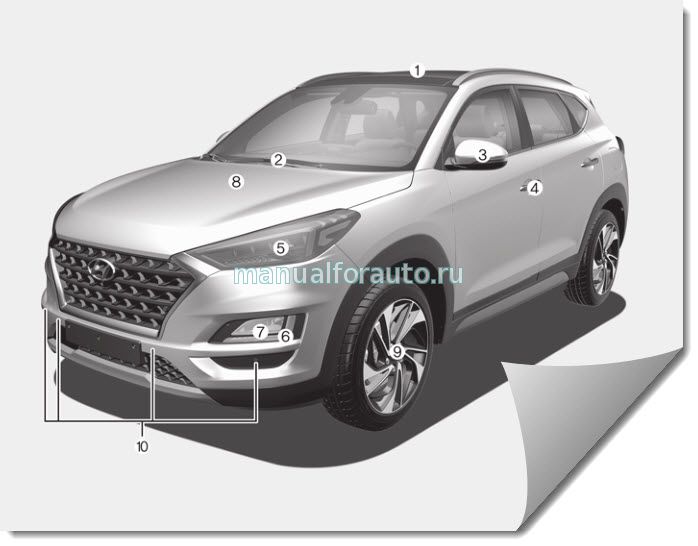- Manuals
- Brands
- Hyundai Manuals
- Automobile
- TUCSON 2018
- Getting started
-
Bookmarks
Quick Links
All manuals and user guides at all-guides.com
2018 Hyundai
TUCSON
Getting Started
Audio, Connectivity, and Navigation
Related Manuals for Hyundai Tucson 2018
Summary of Contents for Hyundai Tucson 2018
-
Page 1
All manuals and user guides at all-guides.com 2018 Hyundai TUCSON Getting Started Audio, Connectivity, and Navigation… -
Page 2
Audio, Connectivity, and Navigation Media 1 Fuel Gauge Media 2 Sunroof Keyfob Steering Light Gear Clock Steering Light Gear ustments 2018 Hyundai Adjustments Table of Contents TUCSON Navigation Phone Rear Smart Car Turn Wiper Seat Seat Seat Seat Pairing utomatic… -
Page 3
Rear Smart Car Turn Camera Features Signals All manuals and user guides at all-guides.com Smartphone Integration Smartphone Bluelink Tailgate 2018 TUCSON Integ Android Auto & Apple CarPlay Connect a USB cable Android Auto Apple CarPlay from your phone to the vehicle’s USB slot. -
Page 4
Gauge Media 1 Media 2 Sunroof Fuel Keyfob All manuals and user guides at all-guides.com Phone Pairing Navigation Phone Rear Smart Car Turn Wiper 2018 TUCSON Pairing Camera Features Signals Navigation and Display Audio The vehicle’s shifter Bluelink Smartphone Tailgate Custom Integ Favorites… -
Page 5
Gauge Media 1 Media 2 Sunroof Fuel Keyfob All manuals and user guides at all-guides.com Phone Pairing Navigation Phone Rear Smart Car Turn Wiper 2018 TUCSON Pairing Camera Features Signals Navigation and Display Audio Your phone may Bluelink Smartphone Tailgate Custom Integ Favorites… -
Page 6
Rear Smart Car Turn Wiper Pairing Camera Features Signals All manuals and user guides at all-guides.com Custom Favorites Initial Setup Smartphone Bluelink Tailgate Custom 2018 TUCSON Integ Favorites Navigation and Display Audio CUSTOM BUTTON (if equipped) The Custom Button ( ) is easy to set up and use so that you can enjoy your favorite features of the multimedia system with the touch of a button. -
Page 7
All manuals and user guides at all-guides.com Making a Call Voice Command Using Bluetooth Voice Bluetooth TPMS 2018 TUCSON Activation Navigation and Display Audio Clock Steering Adjustments BEFORE YOU START Make sure your phone has been paired and your contacts have been downloaded to the vehicle. -
Page 8
All manuals and user guides at all-guides.com Making a Call Voice Command Using Bluetooth Voice Bluetooth TPMS 2018 TUCSON Activation Navigation and Display Audio The selected number Clock Steering Adjustments will be dialed and your contact’s name and phone number will Automatic Manual Seat… -
Page 9
All manuals and user guides at all-guides.com Making a Call Voice Command Using Android Auto/Apple CarPlay Voice Bluetooth TPMS 2018 TUCSON Activation Display Audio Connect a USB cable Android Auto Apple CarPlay Clock Steering Adjustments from your phone to the vehicle’s USB slot. -
Page 10
All manuals and user guides at all-guides.com Making a Call Voice Command Using Android Auto/Apple CarPlay Voice Bluetooth TPMS 2018 TUCSON Activation Display Audio To end the call, press the Clock Steering Adjustments END CALL button on the steering wheel. Automatic Manual Seat… -
Page 11
All manuals and user guides at all-guides.com Making a Call Common Phone Voice Commands Voice Bluetooth TPMS 2018 TUCSON Activation Navigation and Display Audio To start voice command, Clock Steering Adjustments PUSH TO press the TALK button on the steering wheel. Automatic Manual Seat… -
Page 12
All manuals and user guides at all-guides.com Navigation Destination Voice Command Navigation Phone Rear Smart Car Turn Wiper 2018 TUCSON Pairing Camera Features Signals Navigation Bluelink Smartphone Tailgate Custom PUSH TO Press the Integ Favorites TALK button on the steering wheel. You will hear a beep. -
Page 13
All manuals and user guides at all-guides.com Navigation Destination Voice Command Navigation Phone Rear Smart Car Turn Wiper 2018 TUCSON Pairing Camera Features Signals Navigation Bluelink The results will be listed Smartphone Tailgate Custom Integ Favorites on the screen. Say the line item number LINE 3 (for example: “… -
Page 14
All manuals and user guides at all-guides.com Navigation Go to Address Navigation Phone Rear Smart Car Turn Wiper 2018 TUCSON Pairing Camera Features Signals Navigation Bluelink Smartphone Tailgate Custom The vehicle must Integ Favorites PARK be in NAVI Press button. UNIFIED Touch the SEARCH… -
Page 15
All manuals and user guides at all-guides.com Navigation Go to Address Navigation Phone Rear Smart Car Turn Wiper 2018 TUCSON Pairing Camera Features Signals Navigation START GUIDANCE Press Bluelink Smartphone Tailgate Custom Integ Favorites to begin your route. PUSH TO TALK Press the CANCEL button and say “… -
Page 16
Camera Features Signals All manuals and user guides at all-guides.com Smartphone Bluelink Tailgate Custom Destination Search by Voice 2018 TUCSON Integ Favorites Navigation Press the DESTINATION SEARCH button. When prompted, you can say the name of a Point of Interest nearby, an address, or a Point of Interest in a city.
Hyundai Tucson
Мануал рестайла
Dimidrol200888
Был больше месяца назад
Павел Одинцов
Я езжу на Hyundai Tucson и SsangYong Actyon Бензин 2.0 МКПП 2wd
Нижний Новгород, Россия
Может кому то пригодится. Сорян первый раз делаю ссылку)
yadi.sk/d/NgScV-6BJYw5dg
6 января 2019
Метки: просто так
22
7
Ранее Прошивка
Далее Неприятности.
Разместить рекламу
Реклама
Машины в продаже
Волгодонск
Hyundai Tucson, 2015
2 049 900 ₽
Краснодар
Hyundai Tucson, 2018
2 340 000 ₽
Ростов-на-Дону
Hyundai Tucson, 2019
2 849 000 ₽
Ростов-на-Дону
Hyundai Tucson, 2017
2 199 000 ₽
Посмотреть больше машин на Дроме
Комментарии
7
Войдите или зарегистрируйтесь, чтобы писать комментарии, задавать вопросы и участвовать в обсуждении.
Войти
Зарегистрироваться

bsrgin
Я езжу на Hyundai Tucson (TL)
Официальное руководство по эксплуатации, техническое обслуживание, технические характеристики — www.hyundai.ru/media/downloads/pdf/Tucson_TLe.pdf
4 года

daymon77777
Я езжу на Chery Tiggo 8 Pro
такая же хрень не открывает
1
4 года

Dimidrol200888
Автор
Я езжу на Hyundai Tucson (TL)
Пробуем)
4 года

P428HC161RUS
Я езжу на Hyundai Accent (2G)
Перешёл по ссылке а там пишут. Недостаточно прав для просмотра этого файла
2
4 года

Dimidrol200888
Автор
Я езжу на Hyundai Tucson (TL)
Попробуй еще раз
1
4 года

P428HC161RUS
Я езжу на Hyundai Accent (2G)
Во теперь всё нормуль. С Рождеством.
4 года

Dimidrol200888
Автор
Я езжу на Hyundai Tucson (TL)
И Вас с праздником.
1
4 года
инструкцияHyundai Tucson (2018)

OOWWNNEERR‘‘SS MMAANNUUAALL
OOppeerraattiioonn
MMaaiinntteennaannccee
SSppeecciiffiiccaattiioonnss
All information in this Owner’s Manual is current at the time of pub-
lication. However, HYUNDAI reserves the right to make changes at
any time so that our policy of continual product improvement may be
carried out.
This manual applies to all HYUNDAI models and includes descrip-
tions and explanations of optional as well as standard equipment.
As a result, you may find material in this manual that does not apply
to your specific vehicle.
Посмотреть инструкция для Hyundai Tucson (2018) бесплатно. Руководство относится к категории автомобили, 14 человек(а) дали ему среднюю оценку 8.8. Руководство доступно на следующих языках: английский. У вас есть вопрос о Hyundai Tucson (2018) или вам нужна помощь? Задайте свой вопрос здесь

Hyundai Tucson (2018) – это автомобиль внедорожник класса «компакт». Он выпускается Хендай Мотор Компани Limited в Корее и предлагается на рынке в различных странах. Tucson имеет стильный дизайн с узнаваемой хромированной решеткой радиатора, а также современные фары и динамичные линии кузова.
Автомобиль оборудован бензиновым или дизельным двигателем в зависимости от рынка с различной мощностью и объемом. Tucson также предлагается с передним или полным приводом, позволяющим выбрать наиболее подходящую версию для определенных потребностей и условий дороги. Он оснащен автоматической или ручной коробкой передач.
Салон Tucson довольно просторный и привлекательный. В нем имеется достаточно места для пассажиров и багажа. Задние сиденья можно складывать для увеличения объема багажника, что особенно полезно при перевозке крупногабаритных предметов.
Hyundai Tucson (2018) оснащен различными функциями безопасности, такими как система контроля сцепления, электронная стабилизационная программа и подушки безопасности. Также в автомобиле есть различные современные системы дополнительного комфорта и развлечений, такие как камера заднего вида, система навигации и поддержка подключения смартфонов.
Общий вес автомобиля, его габариты и другие технические характеристики могут варьироваться в зависимости от конкретной версии и комплектации. Все это делает Tucson удобным, надежным и подходящим для различных потребностей автомобилем.
Главная
Не можете найти ответ на свой вопрос в руководстве? Вы можете найти ответ на свой вопрос ниже, в разделе часто задаваемых вопросов о Hyundai Tucson (2018).
Как перевести мили в километры?
1 миля равна 1,609344 километрам, а 1 километр — 0,62137119 милям.
Где я могу узнать идентификационный номер транспортного средства Hyundai?
Место размещения идентификационного номера транспортного средства зависит от марки и типа транспортного средства. Номер может быть выбит на раме транспортного средства или указан на номерном знаке. Чтобы узнать место расположения идентификационного номера транспортного средства лучше всего ознакомиться с руководством по эксплуатации Hyundai Tucson (2018).
Что такое идентификационный номер транспортного средства (VIN)?
Идентификационный номер транспортного средства — уникальный для каждого транспортного средства идентификационный номер. Аббревиатура VIN расшифровывается как «Vehicle Identification Number» (Идентификационный номер транспортного средства).
Когда транспортному средству Hyundai требуется техническое обслуживание?
Регулярное техническое обслуживание необходимо всем транспортным средствам. С информацией о том, как часто необходимо проходить техническое обслуживание и чему именно стоит уделять особое внимание можно ознакомиться в инструкции по техническому обслуживанию. Как правило, транспортное средство требует технического обслуживания каждые 2 года или 30 000 километров пробега.
Когда следует заменять тормозную жидкость на Hyundai?
Тормозную жидкость рекомендуется менять каждые два года.
В чем разница между топливом E10 и E5?
В топливе E10 содержится до десяти процентов этанола, в то время как в E5 содержится менее пяти процентов. Соответственно, топливо E10 менее вредит окружающей среде.
Одна или несколько дверей не открываются изнутри. Что мне делать?
Скорее всего, замок оснащен защитой от детей и поэтому не может быть открыт изнутри. Процедура открытия замка с защитой от детей зависит от марки и типа замка.
Автомобильный радиоприемник не включается, что делать?
Если автомобильный радиоприемник не включен, на него не будет подаваться питание. Убедитесь, что красный провод подключен к контактному источнику питания, а желтый провод — к источнику питания постоянной мощности.
Инструкция Hyundai Tucson (2018) доступно в русский?
К сожалению, у нас нет руководства для Hyundai Tucson (2018), доступного в русский. Это руководство доступно в английский.
Не нашли свой вопрос? Задайте свой вопрос здесь
- 18270
Руководство по эксплуатации на Хендай Туссан с 2018 года рестайлинговая модель паркетника с двигателем G4FJ, G4NA и дизелем D4HA на переднем и полным приводе
Хендай Туссан 2018 характеристики
Тип привода Полный (4WD) — передний
Тип кузова SUV
Тип трансмиссии АКПП 6 — МКПП
Объем двигателя, куб.см 1999
Марка кузова TL
Время разгона 0-100 км/ч, с 11.8
Клиренс (высота дорожного просвета), мм 182
Максимальная скорость, км/ч 180
Габариты кузова (Д x Ш x В), мм 4475 x 1850 x 1655
Колесная база, мм 2670
Минимальный радиус разворота, м 5.3
Ширина передней колеи, мм 1608
Ширина задней колеи, мм 1620
Передний свес 910
Задний свес 895
Масса, кг 1604
Максимальная грузоподъёмность 546
Допустимая полная масса, кг 2150
Допустимый вес прицепа без тормозов, кг 750
Допустимый вес прицепа с тормозами, кг 1600
Объем багажника, л 488 (1478)
Расход топлива в городском цикле, л/100 км 11.8
Расход топлива за городом, л/100 км 6.2
Расход топлива в смешанном цикле, л/100 км 8,4
Передняя подвеска Независимая, амортизационная стойка типа МакФерсон
Задняя подвеска Независимая, многорычажная
Передние тормоза Дисковые
Задние тормоза Дисковые
Стояночный тормоз электронный
Заправочные объемы Hyundai Tucson 2018
Масло моторное
Бензиновый 1,6 GDI 3,6л
Бензиновый 1,6 T-GDI 4,5 л
Бензиновый 2,0 MPI 4 л
Бензиновый 2,4 GDI 4,8л
Smartstream D1,6 TCI 4,4 л
Дизельный 2,0 TCI 7,6л
Трансмиссионное для механики API GL-4, SAE 70W
Бензиновый 1,6 GDI 1,6л
Бензиновый 1,6 T-GDI 1,5л
Бензиновый 2,0 MPI 1,4л
Smartstream D1,6 TCI 1,8л
Дизельный 2,0 TCI 1,9л
Трансмиссионное для автомата ATF SP-IV
Бензиновый 1,6 7,3л
Бензиновый 2,0 MPI 7,3л
Бензиновый 2,4 6,7л
Дизельный 2,0 TCI 8,3
Жидкость для коробки передач с двойным сцеплением 2л API GL-4, SAE 70W)
Охлаждающая жидкость
Бензиновый 1,6 GDI 7,1л
Бензиновый 1,6 T-GDI 7,2
Бензиновый 2,0 MPI 7л
Бензиновый 2,4 GDI 7,1
Smartstream D1,6 TCI 7,1
Дизельный 2,0 TCI 8,8
Тормозная жидкость 0,8 DOT-4
Масло заднего дифференциала 0,53 API GL-5, SAE 75W/85
Масло раздаточной коробки API GL-5, SAE 75W/85
Бензиновый 2,0 0,5
Бензиновый 2,4 0,47
Дизельный 2,0 TCI 0,45
Топливо 58л
Лампы Hyundai Tucson
Передние фары
ближний Н7 — LEd
дальний HB3 — LEd
Указатели поворота PY21W — LEd
Габаритные огни — LEd
Противотуманные фары H8
Боковой повторитель указателя поворотов W5W — LEd
Статический фонарь освещения на поворотах H7 — LEd
Задние фары
Стоп-сигналы/задние габаритные огни 21/5W — LED
Задние габаритные огни W5W
Указатель поворота P21W
Фонарь заднего хода W16W
повторитель стоп-сигнала LED
освещение номерного знака W5W
Противотуманная фара P21W — LED
Хендай Туссан руководство
Добавлять комментарии могут только зарегистрированные пользователи.
[
Регистрация
|
Вход
]
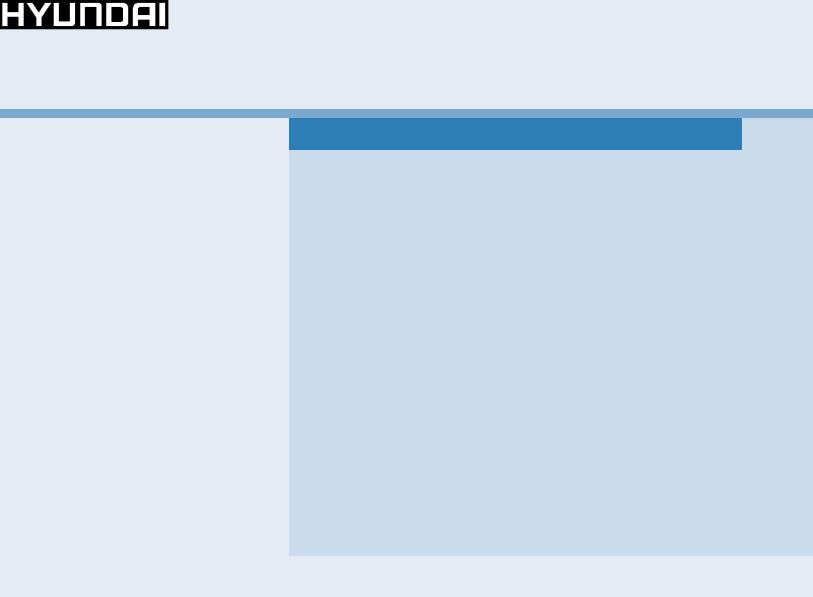
OWNER’S MANUAL
Operation
Maintenance
Specifications
All information in this Owner’s Manual is current at the time of publication. However, HYUNDAI reserves the right to make changes at any time so that our policy of continual product improvement may be carried out.
This manual applies to all HYUNDAI models and includes descriptions and explanations of optional as well as standard equipment. As a result, you may find material in this manual that does not apply to your specific vehicle.
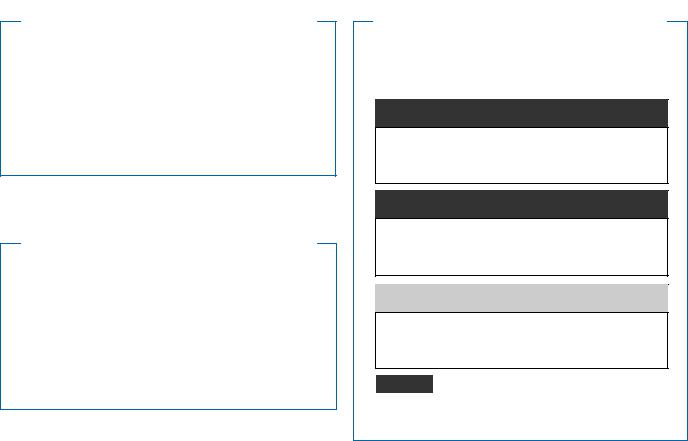
CAUTION: MODIFICATIONS TO
YOUR HYUNDAI
Your HYUNDAI should not be modified in any way.
Such modifications may adversely affect the performance, safety or durability of your HYUNDAI and may, in addition, violate conditions of the limited warranties covering the vehicle. Certain modifications may also be in violation of regulations established by the U.S. Department of
Transportation and other federal or state agencies.
TWO-WAY RADIO OR CELLULAR TELEPHONE INSTALLATION
Your vehicle is equipped with electronic fuel injection and other electronic components. It is possible for an improperly installed/adjusted two-way radio or cellular telephone to adversely affect electronic systems. For this reason, we recommend that you carefully follow the radio manufacturer’s instructions or consult your HYUNDAI dealer for precautionary measures or special instructions if you choose to install one of these devices.
SAFETY AND VEHICLE DAMAGE
WARNING
This manual includes information titled as DAN-
GER, WARNING, CAUTION and NOTICE.
These titles indicate the following:

DANGER indicates a hazardous situation which, if not avoided, will result in death or serious injury.

WARNING indicates a hazardous situation which, if not avoided, could result in death or serious injury.

CAUTION indicates a hazardous situation which, if not avoided, could result in minor or moderate injury.
NOTICE
NOTICE indicates a situation which, if not avoided, could result in vehicle damage.
F2

HYUNDAI VEHICLE OWNER PRIVACY POLICY
Your Hyundai vehicle may be equipped with technologies and services that use information collected, generated, recorded or stored by the vehicle. Hyundai has created a Vehicle Owner Privacy Policy to explain how these technologies and services collect use and share this information.
You may read our Vehicle Owner Privacy Policy on the Hyundaiusa.com website at: https://www.hyundaiusa.com/owner-privacy-policy.aspx
If you would like to receive a hard copy of our Vehicle Owner Privacy Policy, please contact our Customer
Connect Center at:
Hyundai Customer Care P.O. Box 20850
Fountain Valley, CA 92728 800-633-5151 consumeraffairs@hmausa.com
Hyundai’s Customer Connect Center representatives are available Monday through Friday,
between the hours of 5:00 AM and 7:00 PM PST and Saturday and Sunday between 6:30 AM and 3:00 PM PST (English).
For Customer Connect Center assistance in Spanish or Korean, representatives are available Monday through Friday between 6:30 AM and 3:00 PM PST.
F3

INTRODUCTION
Congratulations, and thank you for choosing HYUNDAI. We are pleased to welcome you to the growing number of discriminating people who drive HYUNDAIS. We are very proud of the advanced engineering and high-quality construction of each HYUNDAI we build.
Your Owner’s Manual will introduce you to the features and operation of your new HYUNDAI. To become familiar with your new HYUNDAI, so that you can fully enjoy it, read this Owner’s Manual carefully before driving your new vehicle.
This manual contains important safety information and instructions intended to familiarize you with your vehicle’s controls and safety features so you can safely operate your vehicle.
This manual also contains information on maintenance designed to enhance safe operation of the vehicle. It is recommended that all service and maintenance on your car be performed by an authorized HYUNDAI dealer. HYUNDAI dealers are prepared to provide high-quality service, maintenance and any other assistance that may be required.
This Owner’s Manual should be considered a permanent part of your vehicle, and should be kept in the vehicle so you can refer to it at any time. The manual should stay with the vehicle if you sell it to provide the next owner with important operating, safety and maintenance information.
HYUNDAI MOTOR AMERICA

Severe engine and transmission damage may result from the use of poor quality fuels and lubricants that do not meet HYUNDAI specifications. You must always use high quality fuels and lubricants that meet the specifications listed on Page 8-8 in the Vehicle Specifications section of the Owner’s Manual.
Copyright 2018 HYUNDAI Motor America. All rights reserved. No part of this publication may be reproduced, stored in any retrieval system or transmitted in any form or by any means without the prior written permission of HYUNDAI Motor America.
F4
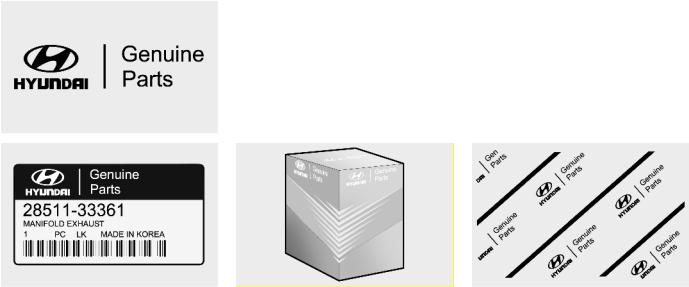
GUIDE TO HYUNDAI GENUINE PARTS
1.What are HYUNDAI Genuine Parts?
HYUNDAI Genuine Parts are the same parts used by HYUNDAI
Motor Company to manufacture vehicles. They are designed and tested for the optimum safety, performance, and reliability for our customers.
2.Why should you use genuine parts?
HYUNDAI Genuine Parts are engineered and built to meet rigid manufacturing requirements. Damage caused by using imitation, counterfeit or used salvage parts is not covered under the HYUNDAI New
Vehicle Limited Warranty or any other HYUNDAI warranty.
In addition, any damage to or failure of HYUNDAI Genuine Parts caused by the installation or failure of an imitation, counterfeit or used salvage part is not covered by any HYUNDAI Warranty.
3.How can you tell if you are purchasing HYUNDAI Genuine Parts?
Look for the HYUNDAI Genuine
Parts Logo on the package (see below).
HYUNDAI Genuine Parts exported to the U.S. are packaged with labels written only in English.
HYUNDAI Genuine Parts are only sold through authorized HYUNDAI Dealerships.
F5
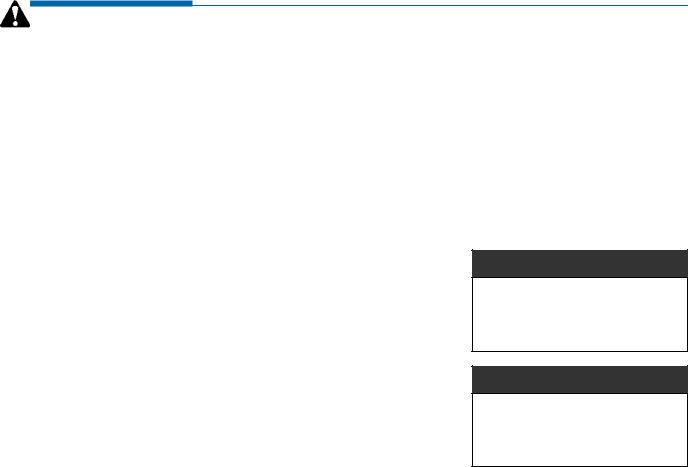
Introduction
HOW TO USE THIS MANUAL
We want to help you get the greatest possible driving pleasure from your vehicle. Your Owner’s Manual can assist you in many ways. To gain an overview of the contents of your
Owner’s Manual, use the Table of
Contents in the front of the manual.
The first page of each Chapter includes a detailed Table of Contents of the Topics in that Chapter.
To quickly locate information about your vehicle, use the Index in the back of the manual. It is an alphabetical list of what is in this manual and the page number where it can be found.
For your convenience, we have incorporated tabs on the right-hand page edges. These tabs are coded with the Chapter titles to assist you with navigating through the manual.
SAFETY MESSAGES
Your safety, and the safety of others, is very important. This Owner’s
Manual provides you with many safety precautions and operating procedures. This information alerts you to potential hazards that may hurt you or others, as well as damage to your vehicle.
Safety messages found on vehicle labels and in this manual describe these hazards and what to do to avoid or reduce the risks.
Warnings and instructions contained in this manual are for your safety. Failure to follow safety warnings and instructions can lead to serious injury or death.
Throughout this manual DANGER,
WARNING, CAUTION, NOTICE and the SAFETY ALERT SYMBOL will be used.
This is the safety alert symbol. It is used to alert you to potential physical injury hazards. Obey all safety messages that follow this symbol to avoid possible injury or death. The safety alert symbol precedes the signal words DANGER, WARNING and CAUTION.

DANGER indicates a hazardous situation which, if not avoided, will result in death or serious injury.

WARNING indicates a hazardous situation which, if not avoided, could result in death or serious injury.
F6
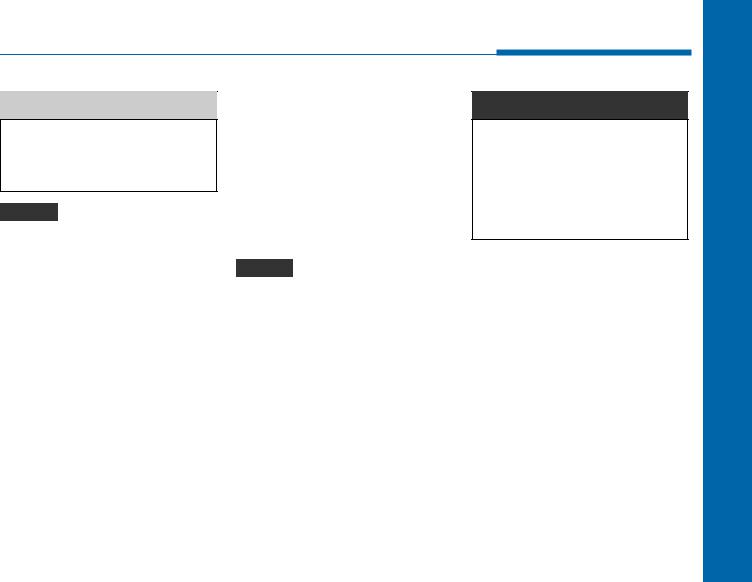

CAUTION indicates a hazardous situation which, if not avoided, could result in minor or moderate injury.
NOTICE
NOTICE indicates a situation which, if not avoided, could result in vehicle damage.
FUEL REQUIREMENTS
Your new vehicle is designed to obtain maximum performance with
UNLEADED FUEL, as well as minimize exhaust emissions and spark plug fouling.
Your new vehicle is designed to use only unleaded fuel having an octane number ((R+M)/2) of 87 (Research
Octane Number 91) or higher. (Do not use methanol blended fuels)
NOTICE
To prevent damage to the engine and engine components, never add any fuel system cleaning agents to the fuel tank other than what has been specified.
Consult an authorized HYUNDAI dealer for additional information.
Introduction

•Do not «top off» after the nozzle automatically shuts off when refueling.
•Always check that the fuel cap is installed securely to prevent fuel spillage in the event of an accident.
Gasoline containing alcohol or methanol
Gasohol, a mixture of gasoline and ethanol (also known as grain alcohol) are being marketed along with or instead of leaded or unleaded gasoline. For example, «E15» is a gasohol comprised of 15% ethanol and 85% gasoline.
Do not use gasohol containing more than 15% ethanol, and do not use gasoline or gasohol containing any methanol. Either of these fuels may cause drivability problems and damage to the fuel system, engine control system and emission control system.
Discontinue using gasohol of any kind if drivability problems occur.
F7

Introduction
«E85» fuel is an alternative fuel comprised of 85 percent ethanol and 15 percent gasoline, and is manufactured exclusively for use in Flexible
Fuel Vehicles. «E85» is not compatible with your vehicle. Use of «E85» may result in poor engine performance and damage to your vehicle’s engine and fuel system. HYUNDAI recommends that customers do not use fuel with an ethanol content exceeding 15 percent.
NOTICE
To prevent damage to your vehicle’s engine and fuel system:
•Never use gasohol which contains methanol.
•Never use gasohol containing more than 15% ethanol.
•Never use leaded fuel or leaded gasohol.
•Never use «E85» fuel.
Your New Vehicle Limited Warranty does not cover damage to the fuel system or any performance problems caused by the use of «E85» fuel.
Using Fuel Additives (except Detergent Fuel Additives)
Using fuel additives such as:
—Silicone fuel additive
—Ferrocene (iron-based) fuel additive
—Other metallic-based fuel additives
may result in cylinder misfire, poor acceleration, engine stalling, damage to the catalyst, or abnormal corrosion, and may cause damage to the engine resulting in a reduction in the overall life of the powertrain.
—The Malfunction Indicator Lamp (MIL) may illuminate.
NOTICE
Damage to the fuel system or performance problem caused by the use of these fuels or fuel additives may not be covered by your New Vehicle Limited Warranty.
Gasoline containing MMT
Some gasoline contains harmful manganese-based fuel additives such as MMT (Methylcyclopentadienyl
Manganese Tricarbonyl).
HYUNDAI does not recommend the use of gasoline containing MMT.
This type of fuel can reduce vehicle performance and affect your emission control system.
The malfunction indicator lamp on the cluster may come on.
Detergent Fuel Additives
HYUNDAI recommends that you use good quality gasolines treated with detergent additives such as TOP TIER Detergent Gasoline, which help prevent deposit formation in the engine. These gasolines will help the engine run cleaner and enhance performance of the Emission Control System. For more information on TOP TIER Detergent Gasoline, please go to the website (www.toptiergas.com).
F8
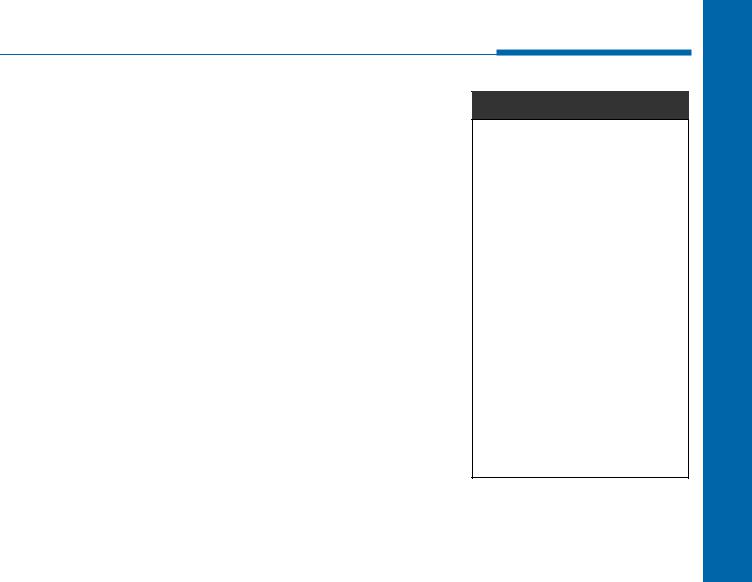
For customers who do not use TOP
Tier Detergent Gasoline regularly, and have problems starting or the engine does not run smoothly, deter- gent-based fuel additives that you can purchase separately may be added to the gasoline. If TOP TIER
Detergent Gasoline is not available, one bottle of additive added to the fuel tank according to the maintenance schedule is recommended
(refer to the Maintenance Schedule in chapter 7).
Additives are available from your authorized HYUNDAI dealer along with information on how to use them. Do not mix other additives.
Operation in foreign countries
If you are going to drive your vehicle in another country, be sure to:
•Observe all regulations regarding registration and insurance.
•Determine that acceptable fuel is available.
VEHICLE BREAK-IN PROCESS
No special break-in period is needed.
By following a few simple precautions for the first 600 miles (1,000 km) you may add to the performance, economy and life of your vehicle.
•Do not race the engine.
•While driving, keep your engine speed (rpm, or revolutions per minute) between 2,000 rpm and 4,000 rpm.
•Do not maintain a single speed for long periods of time, either fast or slow. Varying engine speed is needed to properly break-in the engine.
•Avoid hard stops, except in emergencies, to allow the brakes to seat properly.
Introduction

CALIFORNIA PROPOSITION 65 WARNING
Items contained in motor vehicles or emitted from them are known to the State of California to cause cancer and birth defects or reproductive harm. These include:
•Gasoline and its vapors
•Engine exhaust
•Used engine oil
•Interior passenger compartment components and materials
•Component parts which are subject to heat and wear
In addition, battery posts, terminals and related accessories contain lead, lead compounds and other chemicals known to the State of California to cause cancer and reproductive harm.
F9

Introduction
VEHICLE DATA COLLECTION AND EVENT DATA RECORDERS
This vehicle is equipped with an event data recorder (EDR). The main purpose of an EDR is to record, in certain crash or near crash-like situations, such as an air bag deployment or hitting a road obstacle, data that will assist in understanding how a vehicle’s systems performed. The EDR is designed to record data related to vehicle dynamics and safety systems for a short period of time, typically 30 seconds or less. The EDR in this vehicle is designed to record such data as:
•How various systems in your vehicle were operating;
•Whether or not the driver and passenger safety belts were buckled/ fastened;
•How far (if at all) the driver was depressing the accelerator and/or brake pedal; and,
•How fast the vehicle was traveling.
These data can help provide a better understanding of the circumstances in which crashes and injuries occur. NOTE: EDR data are recorded by your vehicle only if a non-trivial crash situation occurs; no data are recorded by the EDR under normal driving conditions and no personal data (e.g., name, gender, age, and crash location) are recorded. However, other parties, such as law enforcement, could combine the EDR data with the type of personally identifying data routinely acquired during a crash investigation.
To read data recorded by an EDR, special equipment is required, and access to the vehicle or the EDR is needed. In addition to the vehicle manufacturer, other parties, such as law enforcement, that have the special equipment, can read the information if they have access to the vehicle or the EDR.
F10

|
Your vehicle at a glance |
1 |
|||||
|
Safety features of your vehicle |
2 |
|||||
|
Convenient features of your vehicle |
3 |
|||||
|
Multimedia System |
4 |
|||||
|
TABLE OF CONTENTS |
||||||
|
Driving your vehicle |
5 |
|||||
|
What to do in an emergency |
6 |
|||||
|
Maintenance |
7 |
|||||
|
Specifications, Consumer information and |
8 |
|||||
|
Reporting safety defects |
||||||
|
Index |
I |
|||||
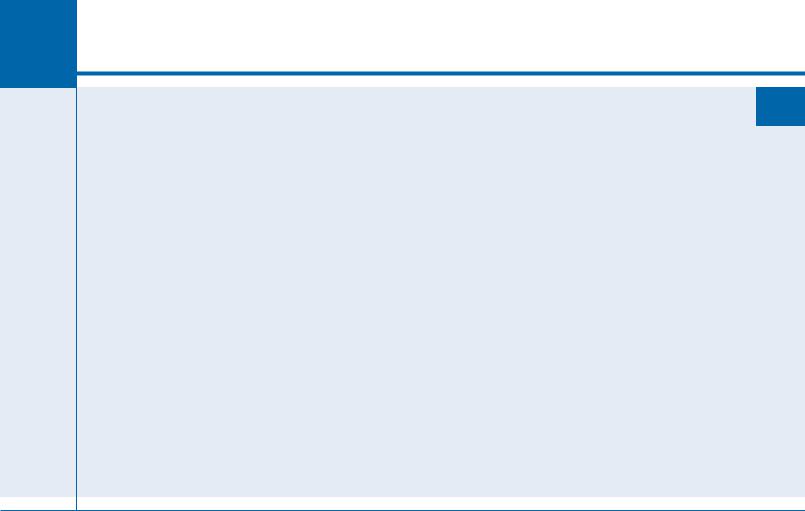
Your vehicle at a glance
|
Exterior overview ………………………………………….. |
1-2 |
|
Interior overview……………………………………………. |
1-4 |
|
Instrument panel overview…………………………….. |
1-5 |
|
Engine compartment ……………………………………… |
1-6 |
1
glance a at vehicle Your

Your vehicle at a glance
EXTERIOR OVERVIEW
Front view
|
1. Panoramic sunroof* ………………………. |
3-42 |
|
|
2. |
Front windshield wiper blades ………… |
7-35 |
|
3. |
Side view mirror ……………………………. |
3-35 |
|
4. |
Door locks …………………………………… |
3-14 |
|
5. |
Headlight …………………………………….. |
7-69 |
|
6. |
Front fog lamp* ……………………………. |
3-110 |
|
7. Hood ……………………………………………. |
3-46 |
|
|
8. Tires and wheels …………………….. |
7-40, 8-6 |
|
|
9. Daytime running lamp* ………… |
3-112, 7-69 |
|
|
*: if equipped |
The actual shape may differ from the illustration.
OTLA015001
1-2
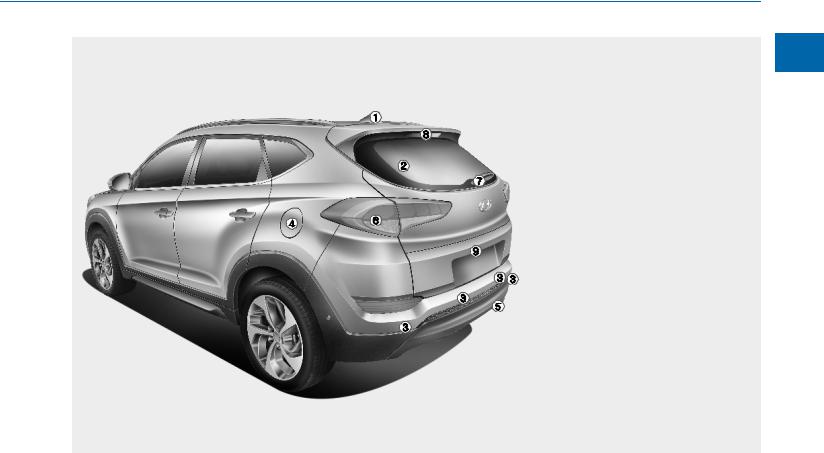
Rear view
|
1. Antenna ………………………………………… |
4-2 |
|
|
2. |
Defroster…………………………………….. |
3-126 |
|
3. |
Parking assist system* …………………. |
3-122 |
|
4. |
Fuel filler door ……………………………… |
3-47 |
|
5. Towing hook …………………………………. |
6-22 |
|
|
6. Rear combination lamp …………………. |
7-79 |
|
|
7. Rear window wiper blade ……………….. |
7-36 |
|
|
8. High mounted stop lamp ……………….. |
7-82 |
|
|
9. Rearview camera ………………………… |
3-121 |
|
|
*: if equipped |
The actual shape may differ from the illustration.
OTL015002
1
glance a at vehicle Your
1-3
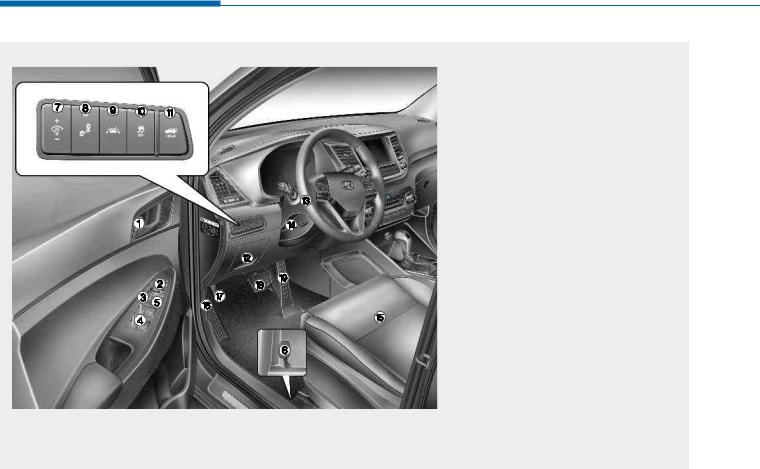
Your vehicle at a glance
INTERIOR OVERVIEW
|
1. |
Door lock/unlock button …………………… |
3-15 |
|
|
2. |
Side view mirror control switch ………….. |
3-37 |
|
|
3. |
Central door lock switch …………………… |
3-16 |
|
|
4. Power window switches …………………… |
3-38 |
||
|
5. Power window lock switch…………………. |
3-41 |
||
|
6. |
Fuel filler door release lever ……………… |
3-47 |
|
|
7. |
Instrument panel illumination control |
||
|
switch ……………………………………………. |
3-64 |
||
|
8. |
Blind spot detection(BSD) system |
||
|
button*……………………………………………. |
5-50 |
||
|
9. Lane departure warning system (LDWS) |
|||
|
button*……………………………………………. |
5-67 |
||
|
10. ESC OFF button ……………………………. |
5-32 |
||
|
11. |
Power liftgate button ………………………. |
3-53 |
|
|
12. Fuse panel …………………………………… |
7-57 |
||
|
13. |
Steering wheel ……………………………… |
3-20 |
|
|
14. |
Steering wheel tilt/telescope lever …… |
3-21 |
|
|
15. |
Seat……………………………………………….. |
2-4 |
|
|
16. |
Hood release lever ………………………… |
3-46 |
|
|
17. |
Parking brake ……………………………….. |
5-28 |
|
|
18. Brake pedal…………………………………… |
5-27 |
||
|
19. |
Accelerator pedal |
||
|
* : if equipped |
The actual shape may differ from the illustration.
OTLA015003
1-4

INSTRUMENT PANEL OVERVIEW
The actual shape may differ from the illustration.
|
1. |
Light control/Turn signals……………… |
3 — 107 |
|
|
2. |
Steering wheel audio controls*/ |
…………4-3 |
|
|
Bluetooth® wireless technology |
|||
|
hands-free controls*………………………… |
4-4 |
||
|
3. |
Instrument cluster ………………………… |
3-63 |
|
|
4. Horn ……………………………………………. |
3-22 |
||
|
5. |
Driver’s front air bag …………………….. |
2-48 |
|
|
6. Wiper/Washer ……………………………. |
3 — 118 |
||
|
7. |
Cruise Control buttons/switch |
………… |
5-72 |
|
8. |
Engine Start/Stop button/ ……………….. |
5-9 |
|
|
Key ignition switch ………………………….. |
5-6 |
||
|
9. |
Automatic transmission/ |
||
|
Dual clutch transmission shifter………. |
5-18 |
||
|
10. Audio/AVN* …………………………………. |
4-4 |
||
|
11. Hazard warning flasher button ………….. |
6-2 |
||
|
12. PASSENGER AIR BAG OFF |
|||
|
indicator …………………………………….. |
2-57 |
||
|
13. Climate control system …….. |
3-126, 3-137 |
||
|
14. AUX, USB …………………………………… |
4-2 |
||
|
15. Power outlet ……………………………… |
3 — 156 |
||
|
16. Cup holder ……………………………….. |
3 — 155 |
||
|
17. Drive mode integrated control |
|||
|
system ………………………………………. |
5-46 |
||
|
18. DBC button ……………………………….. |
5-37 |
||
|
19. AWD LOCK button* …………………….. |
5-41 |
||
|
20. Rear parking assist system* |
………. |
3 — 122 |
|
|
21. Passenger’s front air bag ……………… |
2-48 |
||
|
22. Glove box…………………………………. |
3 — 153 |
||
|
* : if equipped |
OTLA018005
1
glance a at vehicle Your
1-5
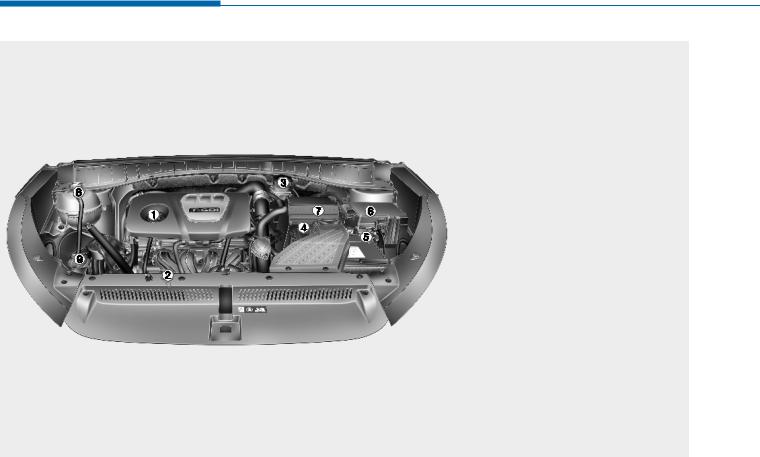
Your vehicle at a glance
ENGINE COMPARTMENT
■ Gamma 1.6 Turbo-GDI
|
1. |
Engine oil filler cap ……………………… |
7-23 |
|
2. |
Engine oil dipstick ……………………….. |
7-22 |
|
3. |
Brake fluid reservoir…………………….. |
7-28 |
|
4. |
Positive battery terminal ………………. |
7-37 |
|
5. |
Negative battery terminal……………… |
7-37 |
|
6. Fuse box ……………………………………. |
7-57 |
|
|
7. |
Air cleaner………………………………….. |
7-30 |
|
8. |
Engine coolant reservoir ………………. |
7-24 |
|
9. Windshield washer fluid reservoir ….. |
7-29 |
The actual engine compartment in the vehicle may differ from the illustration.
OTLE075002
1-6
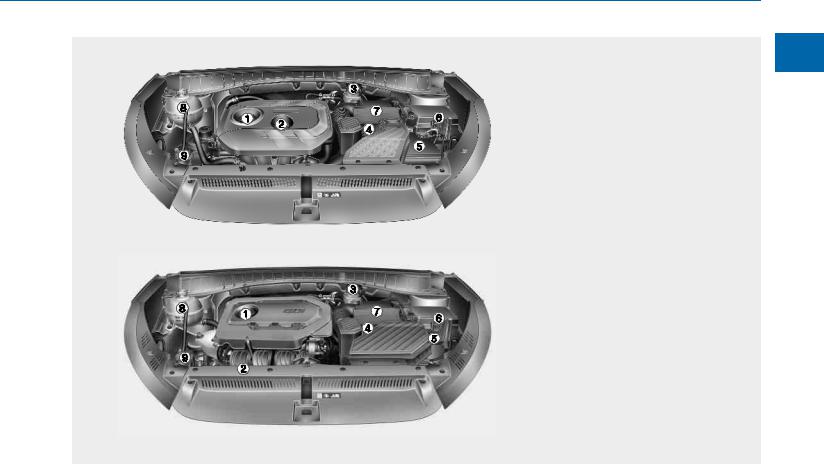
■ Nu 2.0 GDI
■ Theta II 2.4 GDI
|
1. |
Engine oil filler cap ……………………… |
7-23 |
|
2. |
Engine oil dipstick ……………………….. |
7-22 |
|
3. |
Brake fluid reservoir…………………….. |
7-28 |
|
4. |
Positive battery terminal ………………. |
7-37 |
|
5. |
Negative battery terminal……………… |
7-37 |
|
6. Fuse box ……………………………………. |
7-57 |
|
|
7. |
Air cleaner………………………………….. |
7-30 |
|
8. |
Engine coolant reservoir ………………. |
7-24 |
|
9. Windshield washer fluid reservoir ….. |
7-29 |
The actual engine compartment in the vehicle may differ from the illustration.
OTLA075001/OTLE075104
1
glance a at vehicle Your
1-7
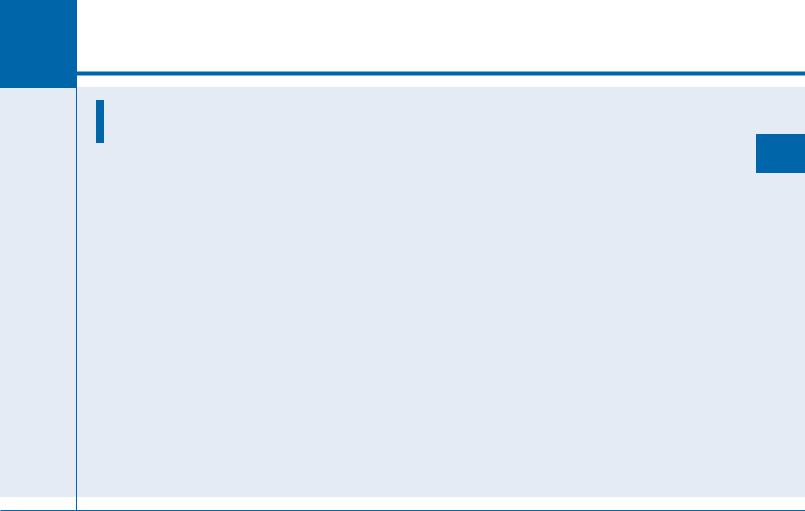
Safety system of your vehicle
This chapter provides you with important information about how to protect yourself and your passengers. It explains how to properly use your seats and seat belts, and how your air bags work.
Additionally, this chapter explains how to properly restrain infants and children in your vehicle.
2
|
Important Safety Precautions………………………… |
2-2 |
Child Restraint System (CRS)……………………….. |
2-36 |
|
Always Wear Your Seat Belt …………………………………… |
2-2 |
|
Restrain All Children………………………………………………… |
2-2 |
|
Air Bag Hazards……………………………………………………….. |
2-2 |
|
Driver Distraction …………………………………………………….. |
2-2 |
|
Control Your Speed………………………………………………….. |
2-3 |
|
Keep Your Vehicle in Safe Condition………………………. |
2-3 |
|
Seats ……………………………………………………………… |
2-4 |
|
Safety Precautions ………………………………………………….. |
2-5 |
|
Front Seats ………………………………………………………………. |
2-6 |
|
Rear Seats………………………………………………………………. |
2-11 |
|
Head restraints………………………………………………………. |
2-14 |
|
Seat warmers and air ventilation seats………………… |
2-18 |
|
Seat Belts…………………………………………………….. |
2-22 |
|
Seat Belt Safety Precautions………………………………… |
2-22 |
|
Seat Belt Warning Light ………………………………………… |
2-23 |
|
Seat Belt Restraint System……………………………………. |
2-24 |
|
Additional Seat Belt Safety Precautions………………. |
2-32 |
|
Care of Seat Belts………………………………………………….. |
2-35 |
|
Children Always in the Rear………………………………….. |
2-36 |
|
Selecting a Child Restraint System (CRS)…………….. |
2-37 |
|
Installing a Child Restraint System (CRS)……………… |
2-39 |
|
Air Bag — |
|
|
Advanced Supplemental Restraint System……. |
2-46 |
|
Where Are the Air Bags?………………………………………. |
2-48 |
|
How Does the Air Bag System Operate?……………… |
2-51 |
|
What to Expect After an Air Bag Inflates……………. |
2-56 |
|
Occupant Classification System (OCS)………………….. |
2-57 |
|
Why Didn’t My Air Bag Go Off in a Collision?…….. |
2-62 |
|
SRS Care ……………………………………………………………….. |
2-67 |
|
Additional Safety Precautions ………………………………. |
2-68 |
|
Air Bag Warning Labels…………………………………………. |
2-69 |

Safety system of your vehicle
IMPORTANT SAFETY PRECAUTIONS
You will find many safety precautions and recommendations throughout this section, and throughout this manual. The safety precautions in this section are among the most important.
Always Wear Your Seat Belt
A seat belt is your best protection in all types of accidents. Air bags are designed to supplement seat belts, not replace them. So even though your vehicle is equipped with air bags, ALWAYS make sure you and your passengers wear your seat belts, and wear them properly.
Restrain All Children
All children under age 13 should ride in your vehicle properly restrained in a rear seat, not the front seat. Infants and small children should be restrained in an appropriate child restraint. Larger children should use a booster seat with the lap/shoulder belt until they can use the seat belt properly without a booster seat.
Air Bag Hazards
While air bags can save lives, they can also cause serious or fatal injuries to occupants who sit too close to them, or who are not properly restrained. Infants, young children, and shorter adults are at the greatest risk of being injured by an inflating air bag. Follow all instructions and warnings in this manual.
Driver Distraction
Driver distraction presents a serious and potentially deadly danger, especially for inexperienced drivers. Safety should be the first concern when behind the wheel and drivers need to be aware of the wide array of potential distractions, such as drowsiness, reaching for objects, eating, personal grooming, other passengers, and using cellular phones.
Drivers can become distracted when they take their eyes and attention off the road or their hands off the wheel to focus on activities other than driving. To reduce your risk of distraction or getting into an accident:
2-2

•ALWAYS set up your mobile devices
(i.e., MP3 players, phones, navigation units, etc.) when your vehicle is parked or safely stopped.
•ONLY use your mobile device when allowed by laws and when conditions permit safe use. NEVER text or email while driving. Most states have laws prohibiting drivers from texting.
Some states and cities also prohibit drivers from using handheld phones.
•NEVER let the use of a mobile device distract you from driving. You have a responsibility to your passengers and others on the road to always drive safely, with your hands on the wheel as well as your eyes and attention on the road.
Control Your Speed
Excessive speed is a major factor in crash injuries and deaths. Generally, the higher the speed, the greater the risk, but serious injuries can also occur at lower speeds. Never drive faster than is safe for current conditions, regardless of the maximum speed posted.
Keep Your Vehicle in Safe
Condition
Having a tire blowout or a mechanical failure can be extremely hazardous. To reduce the possibility of such problems, check your tire pressures and condition frequently, and perform all regularly scheduled maintenance.
2
vehicle your of system Safety
2-3
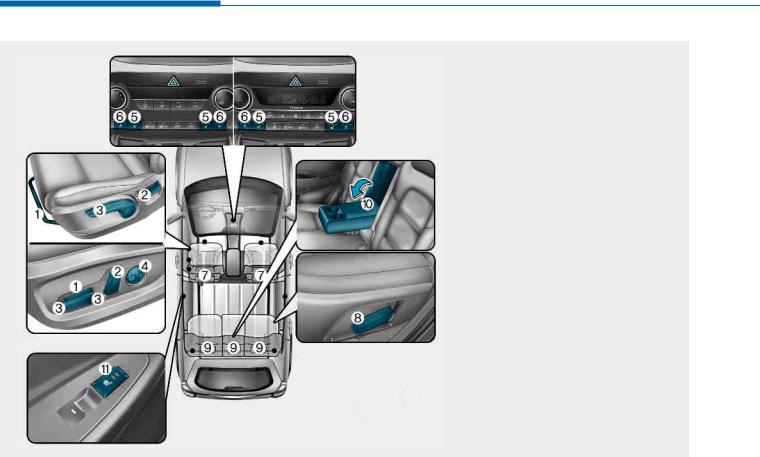
Safety system of your vehicle
SEATS
Front seats
Front seat
(1) Forward and backward
(2) Seatback angle
(3) Seat cushion height (Driver’s seat)
(4) Lumbar support (Driver’s seat)*
(5) Seat warmer*
(6) Air ventilation seat*
(7) Head restraint
Rear seat
(8) Seatback angle and folding
(9) Head restraint
(10) Armrest
(11) Seat warmer*
* : if equipped
OTL035001L
2-4
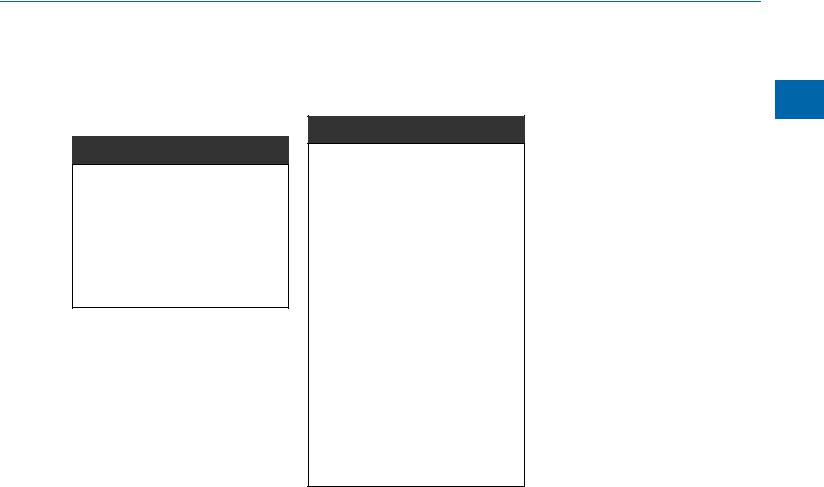
Safety Precautions
Adjusting the seats so that you are sitting in a safe, comfortable position plays an important role in driver and passenger safety together with the seat belts and air bags in an accident.

Do not use a cushion that reduces friction between the seat and the passenger. The passenger’s hips may slide under the lap portion of the seat belt during an accident or a sudden stop. Serious or fatal internal injuries could result because the seat belt cannot operate properly.
Air bags
You can take steps to reduce the risk of being injured by an inflating air bag. Sitting too close to an air bag greatly increases the risk of injury in the event the air bag inflates.
The National Highway Traffic Safety
Administration (NHTSA) recommends that drivers allow at least 10 inches
(25 cm) between the center of the steering wheel and their chest.

To reduce the risk of serious injury or death from an inflating air bag, take the following precautions:
•Adjust the driver’s seat as far to the rear as possible while maintaining the ability to maintain full control of the vehicle.
•Adjust the front passenger seat as far to the rear as possible.
•Hold the steering wheel by the rim with hands at the 9 o’clock and 3 o’clock positions to minimize the risk of injuries to your hands and arms.
•NEVER place anything or anyone between the steering wheel and the air bag.
•Do not allow the front passenger to place feet or legs on the dashboard to minimize the risk of leg injuries.
Seat belts
Always fasten your seat belt before starting any trip.
At all times, passengers should sit upright and be properly restrained.
Infants and small children must be restrained in appropriate child restraint systems. Children who have outgrown a booster seat and adults must be restrained using the seat belts.
2-5
2
vehicle your of system Safety
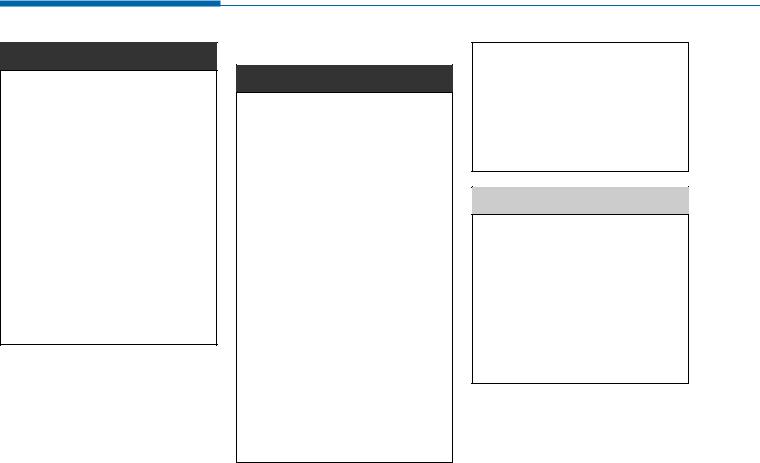
Safety system of your vehicle

Take the following precautions when adjusting your seat belt:
•NEVER use one seat belt for more than one occupant.
•Always position the seatback upright with the lap portion of the seat belt snug and low across the hips.
•NEVER allow children or small infants to ride in a passenger’s lap.
•Do not route the seat belt across your neck, across sharp edges, or reroute the shoulder strap away from your body.
•Do not allow the seat belt to become caught or jammed.
Front Seats

Take the following precautions when adjusting your seat:
•NEVER attempt to adjust the seat while the vehicle is moving. The seat could respond with unexpected movement and may cause loss of vehicle control resulting in an accident.
•Do not place anything under the front seats. Loose objects in the driver’s foot area could interfere with the operation of the foot pedals, causing an accident.
•Do not allow anything to interfere with the normal position and proper locking of the seatback.
•Do not place a cigarette lighter on the floor or seat. When you operate the seat, gas may exit out of the lighter causing a fire.
(Continued)
(Continued)
•Use extreme caution when picking up small objects trapped under the seats or between the seat and the center console. Your hands might be cut or injured by the edges of the seat mechanism.

To prevent injury:
•Do not adjust your seat while wearing your seat belt. Moving the seat cushion forward may cause strong pressure on your abdomen.
•Do not allow your hands or fingers to get caught in the seat mechanisms while the seat is moving.
2-6
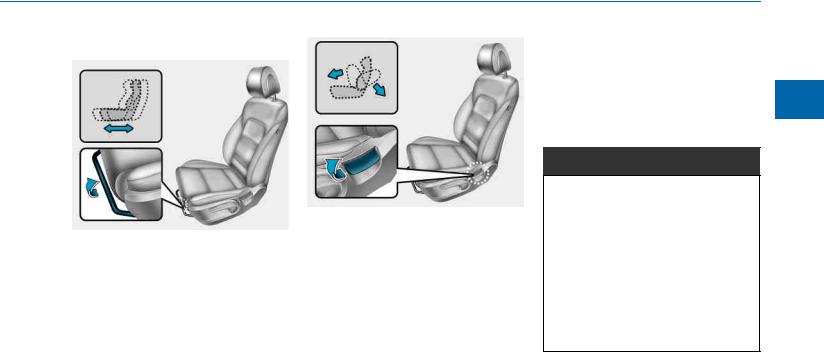
Manual adjustment
OTL035002
Forward and rearward adjustment
To move the seat forward or rearward:
1.Pull up the seat slide adjustment lever and hold it.
2.Slide the seat to the position you desire.
3.Release the lever and make sure the seat is locked in place. Move forward and rearward without using the lever. If the seat moves, it is not locked properly.
OTL035003
Seatback angle
To recline the seatback:
1.Lean forward slightly and lift up the seatback lever.
2.Carefully lean back on the seat and adjust the seatback to the position you desire.
3.Release the lever and make sure the seatback is locked in place.
(The lever MUST return to its original position for the seatback to lock.)
Reclining seatback
Sitting in a reclined position when the vehicle is in motion can be dangerous. Even when buckled up, the protection of your restraint system
(seat belts and air bags) is greatly reduced by reclining your seatback.

NEVER ride with a reclined seatback when the vehicle is moving.
Riding with a reclined seatback increases your chance of serious or fatal injuries in the event of a collision or sudden stop.
Drivers and passengers should ALWAYS sit well back in their seats, properly belted, and with the seatbacks upright.
2
vehicle your of system Safety
2-7
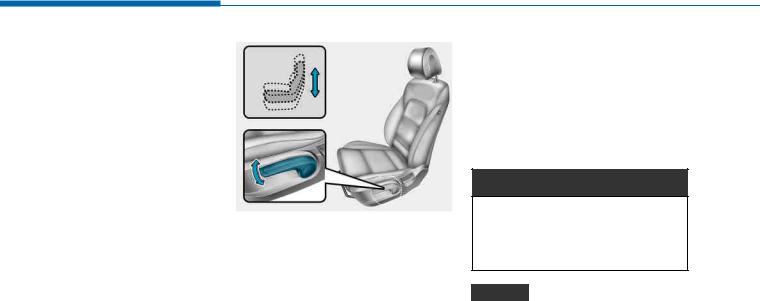
Safety system of your vehicle
Seat belts must be snug against your hips and chest to work properly.
When the seatback is reclined, the shoulder belt is not as effective because it will not be snug against your chest. Instead, it will be in front of you. During an accident, you could be thrown into the seat belt, causing neck or other injuries.
The more the seatback is reclined, the greater chance the passenger’s hips will slide under the lap belt or the passenger’s neck will strike the shoulder belt.
2-8
OTL035004
Seat cushion height
To change the height of the seat cushion:
•Push down on the lever several times, to lower the seat cushion.
•Pull up on the lever several times, to raise the seat cushion.
Power adjustment
The front seat can be adjusted by using the control switches located on the outside of the seat cushion. Before driving, adjust the seat to the proper position so that you can easily control the steering wheel, foot pedals and controls on the instrument panel.

NEVER allow children in the vehicle unattended. The power seats are operable when the engine is turned off.
NOTICE
To prevent damage to the seats:
•Always stop adjusting the seats when the seat has been adjusted as far forward or rearward as possible.
•Do not adjust the seats longer than necessary when the engine is turned off. This may result in unnecessary battery drain.
•Do not operate two or more seats at the same time. This may result in an electrical malfunction.
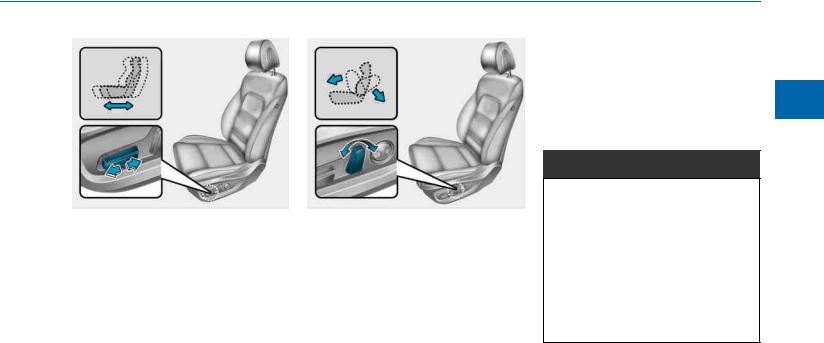
OTL035005
Forward and rearward adjustment
To move the seat forward or rearward:
1.Push the control switch forward or rearward.
2.Release the switch once the seat reaches the desired position.
OTL035006
Seatback angle
To recline the seatback:
1.Push the control switch forward or rearward.
2.Release the switch once the seatback reaches the desired position.
Reclining seatback
Sitting in a reclined position when the vehicle is in motion can be dangerous. Even when buckled up, the protections of your restraint system
(seat belts and air bags) is greatly reduced by reclining your seatback.

NEVER ride with a reclined seatback when the vehicle is moving.
Riding with a reclined seatback increases your chance of serious or fatal injuries in the event of a collision or sudden stop.
Driver and passengers should ALWAYS sit well back in their seats, properly belted, and with the seatbacks upright.
2
vehicle your of system Safety
2-9

Safety system of your vehicle
Seat belts must be snug against your hips and chest to work properly.
When the seatback is reclined, the shoulder belt cannot do its job because it will not be snug against your chest. Instead, it will be in front of you. During an accident, you could be thrown into the seat belt, causing neck or other injuries.
The more the seatback is reclined, the greater chance the passenger’s hips will slide under the lap belt or the passenger’s neck will strike the shoulder belt.
OTL035051
Seat cushion height
To change the height of the seat cushion:
1.Pull the front portion of the control switch up to raise or push down to lower the front part of the seat cushion. Pull the rear portion of the control switch up to raise or push down to lower the seat cushion.
2.Release the switch once the seat reaches the desired position.
OTL035008
Lumbarsupport (fordriver’s seat, if equipped)
To adjust the lumbar support:
1.Press the front portion of the switch to increase support or the rear portion of the switch to decrease support.
2.Release the switch once it reaches the desired position.
2-10
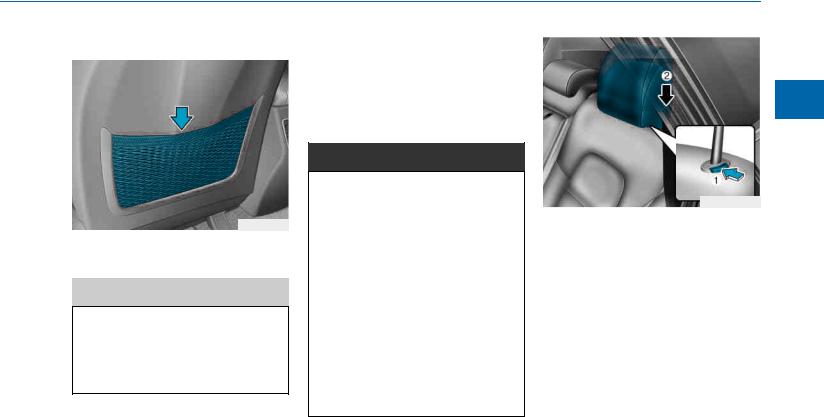
Seatback pocket
OTL035017
The seatback pocket is provided on the back of the front seatbacks.

Do not put heavy or sharp objects in the seatback pockets. In an accident they could come loose from the pocket and injure occupants.
Rear Seats
Folding the rear seat
The rear seatbacks can be folded to facilitate carrying long items or to increase the luggage capacity of the vehicle.

•Never allow passengers to sit on top of the folded down seatback while the vehicle is moving. This is not a proper seating position and no seat belts are available for use. This could result in serious injury or death in case of an accident or sudden stop.
•Objects carried on the folded down seatback should not extend higher than the top of the front seatbacks. This could allow cargo to slide forward and cause injury or damage during sudden stops.
OTLE035060
To fold down the rear seatback:
1.Set the front seatback to the upright position and if necessary, slide the front seat forward.
2.Lower the rear head restraints to the lowest position.
2
vehicle your of system Safety
2-11
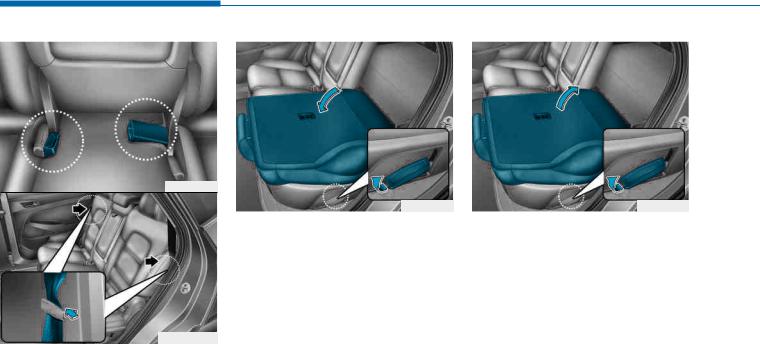
Safety system of your vehicle
OTL035029
OTLE035023
3.Insert the rear seat belt buckle in the pocket between the rear seatback and cushion, and insert the rear seat belt webbing in the guide to prevent the seat belt from being damaged.
OTL035024
4.Fold the seatback toward the front of the vehicle.
OTL035025
5.To use the rear seat, lift and pull the seatback rearward. Pull the seatback firmly until it clicks into place. Make sure the seatback is locked in place.
When you return the seatback to its upright position, always be sure it has locked into position by pushing on the top of the seatback.
2-12


When returning the rear seatback from a folded to an upright position, hold the seatback and return it slowly. Ensure that the seatback is completely locked into its upright position by pushing on the top of the seatback. In an accident or sudden stop, the unlocked seatback could allow cargo to move forward with great force and enter the passenger compartment, which could result in serious injury or death.

Do not place objects in the rear seats, since they cannot be properly secured and may hit vehicle occupants in a collision causing serious injury or death.

Make sure the engine is off, the shift lever is in P (Park), and the parking brake is securely applied whenever loading or unloading cargo. Failure to take these steps may allow the vehicle to move if the shift lever is inadvertently moved to another position.
Armrest
OTLE035021
The armrest is located in the center of the rear seat. Pull the armrest down by using the strap from the seatback to use it.
You will find cup holders on the center armrest.
2
vehicle your of system Safety
2-13

Safety system of your vehicle

•Be careful when loading cargo through the rear passenger seats to prevent damage to the vehicle interior.
•When cargo is loaded through the rear passenger seats, ensure the cargo is properly secured to prevent it from moving while driving.
•Unsecured cargo in the passenger compartment can cause damage to the vehicle or injury to it’s occupants.
Head restraints
The vehicle’s front and rear seats have adjustable head restraints. The head restraints provide comfort for passengers, but more importantly they are designed to help protect passengers from whiplash and other neck and spinal injuries during an accident, especially in a rear impact collision.

To reduce the risk of serious injury or death in an accident, take the following precautions when adjusting your head restraints:
•Always properly adjust the head restraints for all passengers BEFORE starting the vehicle.
•NEVER let anyone ride in a seat with the head restraints removed.
(Continued)
(Continued)
•
OLF034072N
Adjust the head restraints so the middle of the head restraints is at the same height as the height of the top of the eyes.
•NEVER adjust the head restraint position of the driver’s seat when the vehicle is in motion.
•Adjust the head restraint as close to the passenger’s head as possible. Do not use a seat cushion that holds the body away from the seatback.
•Make sure the head restraint locks into position after adjusting it.
2-14

NOTICE
To prevent damage, NEVER hit or pull on the head restraints.
Front seat head restraints
OLMB033009
The vehicle’s front seats are equipped with adjustable head restraints for both safety and comfort.
OTL035014
Forward and rearward adjustment
The headrest may be adjusted forward to 3 different positions by pulling the headrest forward to the desired detent. To adjust the headrest to it’s furthest rearwards position, pull it fully forward to the farthest position and release it.
2
vehicle your of system Safety
2-15

Safety system of your vehicle
OTL035009
Adjusting the height up and down
To raise the head restraint:
1. Pull it up to the desired position (1).
To lower the head restraint:
1.Push and hold the release button
(2) on the head restraint support.
2.Lower the head restraint to the desired position (3).
OLF034015
NOTICE
If you recline the seatback towards the front with the head restraint and seat cushion raised, the head restraint may come in contact with the sunvisor or other parts of the vehicle.
■ Manual seat
OTL035010
■ Power seat
OTL035011
Removal/Reinstallation
To remove the head restraint:
1.Recline the seatback (2) rearward using the seatback angle lever/ switch (1).
2.Raise the head restraint as far as it can go.
2-16

3.Press the head restraint release button (3) while pulling upward on the head restraint (4).
■ Manual seat
OTL035012
■ Power seat
OTL035013
To reinstall the head restraint:
1.Put the head restraint poles (2) into the holes while pressing the release button (1).
2.Adjust the head restraint to the appropriate height.
3.Recline the seatback (4) forward using the seatback angle lever/ switch (3).
Rear seat head restraints
OLMB033016
The rear seats are equipped with head restraints in all seating positions for passenger safety and comfort.
2
vehicle your of system Safety
2-17

Safety system of your vehicle
OTL035018
Adjusting the height up and down
To raise the head restraint:
1. Pull it up to the desired position (1).
To lower the head restraint:
1.Push and hold the release button
(2) on the head restraint support.
2.Lower the head restraint to the desired position (3).
OTLA035018
Removal/Reinstallation
To remove the head restraint:
1.Raise the head restraint as far as it can go.
2.Press the head restraint release button (1) while pulling the head restraint up (2).
To reinstall the head restraint:
1.Put the head restraint poles into the holes (3) while pressing the release button (1).
2.Adjust the head restraint to the appropriate height.
Seat warmers and air ventilation seats
Front seat warmers (if equipped)
Seat warmers are provided to warm the seats during cold weather.

The seat warmers can cause a SERIOUS BURN, even at low temperatures and especially if used for long periods of time.
Passengers must be able to feel if the seat is becoming too warm so they can turn it off, if needed.
People who cannot detect temperature change or pain to the skin should use extreme caution, especially the following types of passengers:
•Infants, children, elderly or disabled persons, or hospital outpatients.
•People with sensitive skin or who burn easily.
•Fatigued individuals.
•Intoxicated individuals.
(Continued)
2-18

(Continued)
•People taking medication that can cause drowsiness or sleepiness.

NEVER place anything on the seat that insulates against heat when the seat warmer is in operation, such as a blanket or seat cushion. This may cause the seat warmer to overheat, causing a burn or damage to the seat.
NOTICE
To prevent damage to the seat warmers and seats:
•Never use a solvent such as paint thinner, benzene, alcohol or gasoline to clean the seats.
•Do not place heavy or sharp objects on seats equipped with seat warmers.
•Do not change the seat cover. It may damage the seat warmer.
■ Type A
OTLE035075
■ Type B
OTLE035076
While the engine is running, push either of the switches to warm the driver’s seat or front passenger’s seat.
2
vehicle your of system Safety
2-19

Safety system of your vehicle
Front air ventilation seat (if equipped)
■ Type A
OTLE035016
■ Type B
OTLE035015

To prevent damage to the air ventilation seat:
•Use the air ventilation seat ONLY when the climate control system is on. Using the air ventilation seat for prolonged periods of time with the climate control system off could cause the air ventilation seat to malfunction.
•Never use a solvent such as paint thinner, benzene, alcohol or gasoline to clean the seats.
(Continued)
2-20

(Continued)
•Avoid spilling liquids on the surface of the front seats and seatbacks; this may cause the air vent holes to become blocked and not work properly.
•Do not place materials such as plastic bags or newspapers under the seats. They may block the air intake causing the air vents to not work properly.
•Do not change the seat covers. It may damage the air ventilation seat.
•If the air vents do not operate, restart the vehicle. If there is no change, have the vehicle inspected by an authorized HYUNDAI dealer.
Rear seat warmers (if equipped)
OTL035022
While the engine is running, push either of the switches to warm the rear seat.
During mild weather or under conditions where the operation of the seat warmer is not needed, keep the switches in the OFF position.
2
vehicle your of system Safety
2-21

Safety system of your vehicle
SEAT BELTS
This section describes how to use the seat belts properly. It also describes some of the things not to do when using seat belts.
Seat Belt Safety Precautions
Always fasten your seat belt and make sure all passengers have fastened their seat belts before starting any trip. Air bags are designed to supplement the seat belt as an additional safety device, but they are not a substitute. Most states require all occupants of a vehicle to wear seat belts.

Seat belts must be used by ALL passengers whenever the vehicle is moving. Take the following precautions when adjusting and wearing seat belts:
•ALWAYS properly restrain children under age 13 in the rear seats.
•NEVER allow children to ride in the front passenger seat. If a child age 13 or older must be seated in the front seat, move the seat as far back as possible and properly restrain them in the seat.
•NEVER allow an infant or child to be carried on an occupant’s lap.
•NEVER ride with the seatback reclined when the vehicle is moving.
•Do not allow children to share a seat or seat belt.
(Continued)
(Continued)
•Do not wear the shoulder belt under your arm or behind your back.
•Always wear both the shoulder portion and lap portion of the lap/shoulder belt.
•Do not use the seat belt if it is twisted. A twisted seat belt will not protect you properly in an accident.
•Do not use a seat belt if the webbing or hardware is damaged.
•Do not latch the seat belt into the buckles of other seats.
•NEVER unfasten the seat belt while driving. This may cause loss of vehicle control resulting in an accident.
•Make sure there is nothing in the buckle interfering with the seat belt latch mechanism. This may prevent the seat belt from fastening securely.
(Continued)
2-22

(Continued)
•No modifications or additions should be made by the user which will either prevent the seat belt adjusting devices from operating to remove slack, or prevent the seat belt assembly from being adjusted to remove slack.

Damaged seat belts and seat belt assemblies will not operate properly. Always replace:
•Frayed, contaminated, or damaged webbing
•Damaged hardware
•The entire seat belt assembly after it has been worn in an accident, even if damage to webbing or assembly is not apparent
Seat Belt Warning Light
Seat belt warning light (for driver’s seat)
OLMB033022
The driver’s seat belt warning light and chime will come on according to the following table when the ignition switch is in the ON position.
|
Conditions |
Warning Pattern |
||||
|
Seat Belt |
Vehicle |
Light (Blink) |
Chime |
||
|
Speed |
|||||
|
Unbuckled |
6 seconds |
||||
|
Buckled |
6 seconds |
None |
|||
|
Below 3 mph |
6 seconds |
None |
|||
|
(5 km/h) |
|||||
|
Buckled → |
|||||
|
3 mph~ |
6 seconds |
||||
|
Unbuckled |
6 mph |
||||
|
Above 6 mph |
6 sec. ON / 24 sec. OFF |
||||
|
(10 km/h) |
(11 times) |
||||
|
Above 6 mph |
|||||
|
(10 km/h) |
6 seconds *1 |
||||
|
Unbuckled |
↓ |
↓ |
|||
|
Below 3 mph |
Stop *2 |
||||
|
(5 km/h) |
|||||
*1 : The Warning Pattern repeats 11 times with an interval of 24 seconds. If the driver’s seat belt is buckled, the light will stop within 6 seconds and chime will stop immediately.
*2 : The light will stop within 6 seconds and chime will stop immediately.
2
vehicle your of system Safety
2-23

Safety system of your vehicle
Seat belt warning light
(for front passenger’s seat)
OTLE035082
The front passenger’s seat belt warning light will activate to the following table when the ignition switch is in «ON» position.
|
Conditions |
Warning |
||
|
Pattern |
|||
|
Seat Belt |
Vehicle |
Light-Blink |
|
|
Speed |
|||
|
Unbuckled |
6 seconds |
||
|
Unbuckled |
Above 6mph |
Continuously |
|
|
(10 km/h) |
|||
|
Buckled |
6 seconds |
||
|
Above 6mph |
Continuously *1 |
||
|
Buckled → |
(10 km/h) |
||
|
Unbuckled |
|||
|
Below 6mph |
None |
||
|
(10 km/h) |
|||
*1 : The seat belt warning light will go off if the vehicle speed decreases below 3 mph (5 km/h). If the vehicle speed increases above 3 mph (5 km/h), the warning light will blink again.
Seat Belt Restraint System
Seat Belt-Driver’s 3-point system with emergency locking retractor
ODH033055
To fasten yourseat belt:
Pull the seat belt out of the retractor and insert the metal tab (1) into the buckle (2). There will be an audible «click» when the tab locks into the buckle.
2-24

ODH033053
You should place the lap belt (1) portion across your hips and the shoulder belt (2) portion across your chest.
The seat belt automatically adjusts to the proper length after the lap belt portion is adjusted manually so that it fits snugly around your hips. If you lean forward in a slow, easy motion, the belt will extend and move with you.
If there is a sudden stop or impact, the belt will lock into position. It will also lock if you try to lean forward too quickly.
NOTICE
If you are not able to smoothly pull enough of the seat belt out from the retractor, firmly pull the seat belt out and release it. After release, you will be able to pull the belt out smoothly.
OLMB033025

Improperly positioned seat belts may increase the risk of serious injury in an accident. Take the following precautions when adjusting the seat belt:
•Position the lap portion of the seat belt as low as possible across your hips, not on your waist, so that it fits snugly.
(Continued)
2
vehicle your of system Safety
2-25

Safety system of your vehicle
(Continued)
•Position one arm under the shoulder belt and the other over the belt, as shown in the illustration.
•Always position the shoulder belt anchor into the locked position at the appropriate height.
•Never position the shoulder belt across your neck or face.
Height adjustment
You can adjust the height of the shoulder belt anchor to one of the four different positions for maximum comfort and safety.
The shoulder portion should be adjusted so it lies across your chest and midway over your shoulder nearest the door, not over your neck.
■ Front seat
OTL035026
To adjust the height of the seat belt anchor, lower or raise the height adjuster into an appropriate position.
To raise the height adjuster, pull it up
(1). To lower it, push it down (3) while pressing the height adjuster button (2).
Release the button to lock the anchor into position. Try sliding the height adjuster to make sure that it has locked into position.
Rear Seat Belt – Passenger’s 3- point system with convertible locking retractor
This type of seat belt combines the features of both an emergency locking retractor seat belt and an automatic locking retractor seat belt. Convertible retractor type seat belts are installed in the rear seat positions to help accommodate the installation of child restraint systems. Although a convertible retractor is also installed in the front passenger seat position, NEVER place any infant/child restraint system in the front seat of the vehicle.
2-26

To fasten the rear center seat belt
2.Insert the small tongue plate (A) into the primary buckle (B) located on the right hand (passenger) side of the center seat. Insert the buckle until an audible «click» is heard, indicating that the latch is locked.
Make sure the belt is not twisted.
OTLE035110
OTLE035111
1.Extract the small tongue plate from the slot on the belt assembly pocket located in the headliner.
OTLE035112
OTL035113
3.Slip the large tongue plate (C) out of the pocket (D) located on the belt assembly.
2
vehicle your of system Safety
2-27

Safety system of your vehicle
4.Pull the large tongue plate and insert it into the seat belt buckle
(E)located on the left hand (driver) side of the center seat. Insert the buckle until an audible «click» is heard, indicating that the latch is locked. Make sure the belt is not twisted.
When using the rear center seat belt, the buckle with the «CENTER» mark must be used.
i Information
Ifyouarenotabletopulloutthesafety belt from the retractor, firmly pull the belt out and release it. After release,youwillbeabletopullthebelt out smoothly.
OTLE035084
To release yourseat belt:
Press the release button (1) in the locking buckle.
When it is released, the belt should automatically draw back into the retractor. If this does not happen, check the belt to be sure it is not twisted, then try again.
To release the rear center seatbelt
OTL035114
1.Press the release button on the rear center seat belt buckle (E) located on the left hand (driver) side of the center seat and remove the large tongue plate (C).
2-28

OTL035115
OTLE035116
2.To release and retract the rear center seatbelt assembly, insert a small tool or key into the primary buckle release hole (F) located on the right hand (passenger) side of the center seat. You can also insert the large buckle (C) into the release hole to release the seat belt assembly.
Pull up on the seat belt webbing and allow the webbing to retract automatically.
3.Slip the large tongue plate (C) into the pocket (D) located on the belt assembly.
OTLE035078
4. Insert the small tongue plate (A) into the slot on the belt assembly pocket located in the headliner.
2
vehicle your of system Safety
2-29

Safety system of your vehicle
Pre-tensioner seat belt
OTL035053
Your vehicle is equipped with driver’s and front passenger’s Pre-tensioner Seat Belts (Retractor Pretensioner and Emergency Fastening Device (EFD)). The purpose of the pre-ten- sioner is to make sure the seat belts fit tightly against the occupant’s body in certain frontal collisions. The Seat Belt Anchor Pre-tensioner may be activated in certain crashes where the frontal collision is severe enough, together with the air bags.
When the vehicle stops suddenly, or if the occupant tries to lean forward too quickly, the seat belt retractor will lock into position. In certain frontal collisions, the pre-tensioner will activate and pull the seat belt into tighter contact against the occupant’s body.
(1)Retractor Pretensioner
The purpose of the retractor pretensioner is to make sure that the shoulder belts fit in tightly against the occupant’s upper body in certain frontal collisions.
(2)Emergency Fastening Device (EFD) (for the driver’s seat)
The purpose of the EFD is to make sure that the pelvis belts fit in tightly against the occupant’s lower body in certain frontal collisions.
If the system senses excessive tension on the driver or passenger’s seat belt when the pre-tensioner system activates, the load limiter inside the retractor pre-tensioner will release some of the pressure on the affected seat belt.

•Always wear your seat belt and sit properly in your seat.
•Do not use the seat belt if it is loose or twisted. A loose or twisted seat belt will not protect you properly in an accident.
•Do not place anything near the buckle. This may adversely affect the buckle and cause it to function improperly.
•Always replace your pre-ten- sioners after activation or an accident.
•NEVER inspect, service, repair or replace the pre-tensioners yourself. This must be done by an authorized HYUNDAI dealer.
•Do not hit the seat belt assemblies.
2-30


Do not touch the pre-tensioner seat belt assemblies for several minutes after they have been activated. When the pre-ten- sioner seat belt mechanism deploys during a collision, the pre-tensioners become hot and can burn you.
OLMB033040/Q
The Pre-Tensioner Seat Belt System consists mainly of the following components. Their locations are shown in the illustration above:
(1)SRS air bag warning light
(2)Retractor pre-tensioner
(3)SRS control module
(4)Emergency Fastening Device (EFD)
NOTICE
The sensor that activates the SRS air bag is connected with the pre–tensioner seat belts. The SRS air bag warning light on the instrument panel will illuminate for approximately 6 seconds after the ignition switch is in the ON position, and then it should turn off.
If the pre-tensioner is not working properly, the warning light will illuminate even if the SRS air bag is not malfunctioning. If the warning light does not illuminate, stays illuminated or illuminates when the vehicle is being driven, have an authorized HYUNDAI dealer inspect the pre-tensioner seat belts and SRS air bags as soon as possible.
2-31
2
vehicle your of system Safety

Safety system of your vehicle
NOTICE
•Both the driver’s and front passenger’s pre-tensioner seat belts may be activated in certain frontal or side collisions or rollovers.
•The passenger side pre-tension- ers will not be activated if the seat belts are not worn at the time of the collision.
•When the pre-tensioner seat belts are activated, a loud noise may be heard and fine dust, which may appear to be smoke, may be visible in the passenger compartment. These are normal operating conditions and are not hazardous.
•Although it is non-toxic, the fine dust may cause skin irritation and should not be breathed for prolonged periods. Wash all exposed skin areas thoroughly after an accident in which the pre-tensioner seat belts were activated.
Additional Seat Belt Safety Precautions
Seat belt use during pregnancy
The seat belt should always be used during pregnancy. The best way to protect your unborn child is to protect yourself by always wearing the seat belt.
Pregnant women should always wear a lap-shoulder seat belt. Place the shoulder belt across your chest, routed between your breasts and away from your neck. Place the lap belt below the belt line so that it fits snugly and as low as possible across the hips, not across the abdomen.

To reduce the risk of serious injury or death to an unborn child during an accident, pregnant women should NEVER place the lap portion of the seat belt above or over the area of the abdomen where the unborn child is located.
Seat belt use and children
Infant and small children
All 50 states have child restraint laws which require children to travel in approved child restraint devices, including booster seats. The age at which seat belts can be used instead of child restraints differs among states, so you should be aware of the specific requirements in your state, and where you are travelling. Infant and child restraints must be properly placed and installed in a rear seat. For more information refer to the «Child Restraint Systems» section in this chapter.
2-32








